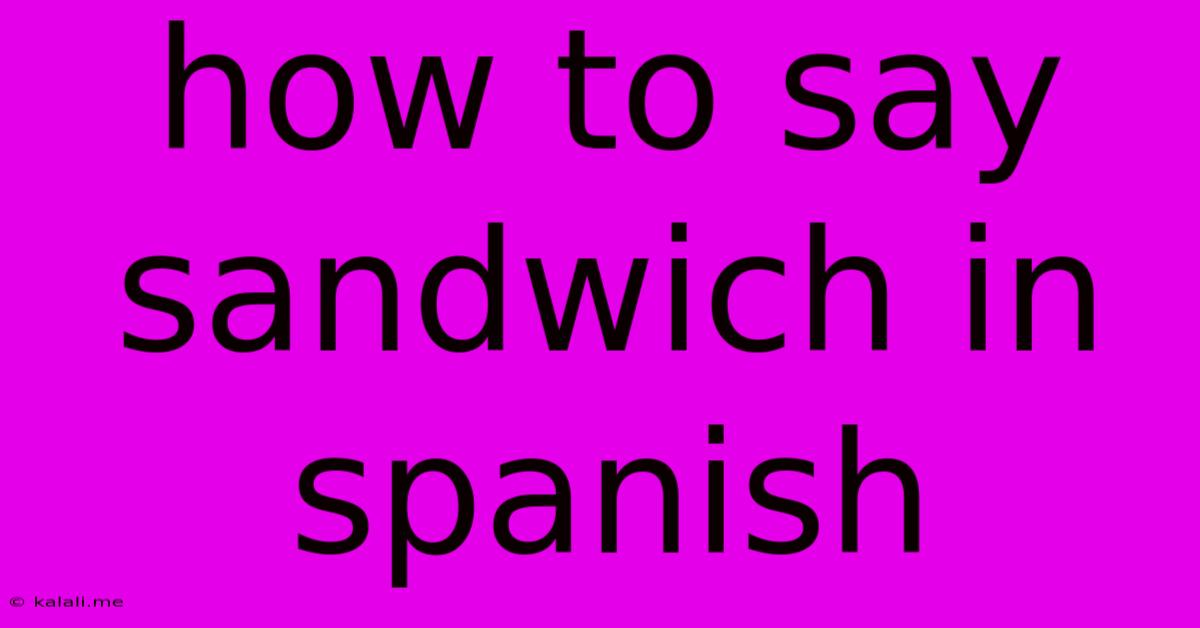How To Say Sandwich In Spanish
Kalali
May 29, 2025 · 3 min read

Table of Contents
How to Say Sandwich in Spanish: More Than Just "Sándwich"
So, you want to know how to say "sandwich" in Spanish? While the most straightforward answer is sándwich, it's not quite that simple! This seemingly simple question opens up a world of regional variations, colloquialisms, and interesting linguistic nuances. This article will explore the different ways to say sandwich in Spanish, helping you choose the perfect word for any situation.
This post will cover the various ways to say sandwich in Spanish, including the most common translation, regional alternatives, and when to use each term. We'll also delve into the history of the word "sándwich" in the Spanish language. By the end, you'll be a sandwich-ordering expert in Spanish!
The Most Common Way: Sándwich
The most common and widely understood way to say "sandwich" in Spanish is, unsurprisingly, sándwich. It's a loanword directly borrowed from English, and it's understood throughout the Spanish-speaking world. This is your safest bet in most situations.
Regional Variations and Alternatives
While sándwich is ubiquitous, regional variations and alternative terms exist, adding richness and color to the Spanish language. Depending on the region and context, you might hear other words used. These can vary greatly based on local customs and traditions surrounding sandwiches.
-
Bocadillo: This is a very common term in Spain, especially in Spain and parts of Latin America. A bocadillo refers to a sandwich made with bread – usually a baguette or a similar type of bread – that has some kind of filling. It often implies a simpler, perhaps more rustic sandwich than what might be considered a "sándwich" in some contexts. Think of a classic jamón serrano bocadillo.
-
Sanguche: This term, predominantly used in Argentina and Uruguay, is a shorter and more informal version. It’s a colloquialism that adds a certain casualness to the conversation.
-
Emparedado: This is another option that you might come across in some parts of Latin America. It literally translates to "walled-up" which illustrates the sandwich being created by "walling up" the filling within the bread.
Choosing the Right Word: Context is Key
The best way to say "sandwich" in Spanish depends heavily on context.
-
Formal settings: Stick with sándwich. It’s universally understood and leaves no room for misinterpretation.
-
Informal settings, Spain: Bocadillo is your go-to option.
-
Informal settings, Argentina/Uruguay: Use sanguche.
-
Latin American contexts (varies regionally): While sándwich is usually safe, emparedado may be heard depending on the specific area.
The History of "Sándwich" in Spanish
The word sándwich itself has a fascinating history. It reflects the global spread of English, and particularly the influence of English cuisine, across different cultures. Its direct adoption into Spanish (and many other languages) is a testament to the widespread popularity and recognizability of the sandwich itself.
Mastering Sandwich Vocabulary in Spanish
By understanding these variations, you'll not only be able to order a sandwich confidently in Spanish but also engage in more nuanced conversations about food and culture. So next time you find yourself craving a sandwich in a Spanish-speaking country, you'll be prepared! Remember to consider the context and location when choosing your word. Enjoy your sándwich, bocadillo, sanguche, or emparedado!
Latest Posts
Latest Posts
-
Furnace Humming But Not Turning On
May 30, 2025
-
How Long Can An Essay Be
May 30, 2025
-
The Gift Of The Holy Spirit
May 30, 2025
-
Drop By But Unfortunately Didnt Meet
May 30, 2025
-
How To Sleep In Stardew Valley
May 30, 2025
Related Post
Thank you for visiting our website which covers about How To Say Sandwich In Spanish . We hope the information provided has been useful to you. Feel free to contact us if you have any questions or need further assistance. See you next time and don't miss to bookmark.